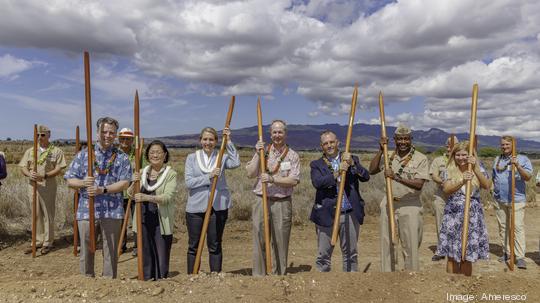
Green limits
I like nice round numbers, they help me visualize things. For example, we had a story this week about a groundbreaking and blessing ceremony for the Kupono Solar Project.
The projected is developed by Ameresco Inc., and Bright Canyon Energy, on 131 acres at the Joint Base Pearl Harbor-Hickam West Loch Annex. It’s a solar-plus-storage project, featuring a 42-megawatt photovoltaic solar array and a 42-MW/168 MWh lithium-ion battery storage system. It has a power purchase agreement with Hawaiian Electric for 20 years.
Here are some round numbers from the press release to keep in mind:
The project generates enough electricity to power 10,000 homes.
The battery back-up is good for four hours of power.
What we’ve got here are enough numbers to extrapolate what our mandated carbon-free future looks could like, if solar is our go-to solution. How many solar installations, covering how much land do we need?
This project covers 131 acres to power the equivalent of 10,000 homes.
According to the U.S. Census Bureau, Oahu has 372,626 housing units.
Divide that by 10,000 — we would need at least 37 projects the size of Kupono.
Combined, they’d cover 4,847 acres, or 7.57 square miles, to generate as much electricity as Oahu’s 372,626 housing units need.
If it helps to visualize what 4,847 acres looks like, Waikiki is 2,176 acres, so the equivalent of a bit more than two Waikikis.
But wait, what about at night, when the sun doesn’t shine? The Kupono’s battery back-up is good for four hours. Nights in Hawaii range from 10.5 hours long in the summer to 13 hours long in the winter. During our long winter nights, we’d need 3.25 times the battery storage we’d get from simply replicating Kupono 37 times. Does that mean we’d need to devote the equivalent of six Waikiki’s to solar to get our housing through the night?
Probably not. I don’t know offhand how much acreage is devoted to just Kupono’s batteries, but it must be some fraction of what the panels cover. Let’s just say, somewhere between two and six Waikikis, with batteries included.
But wait, there’s more! The electricity needs of everything on Oahu that is not housing. All that will need panels and batteries too! And we have to install it all by 2045, by law.
The W.E.s — “Waikiki Equivalents” — just keep adding up.
Of course, some of this has already been built, distributed across thousands of rooftops. Going forward, however, land-intensive, utility-scale projects with battery back-ups are the plan.
Sane and rational
Kudos to the Practical Policy Institute for its recent editorial in the Honolulu Star-Advertiser about Bill 41 being considered by the Honolulu City Council. As authors John Kim and Ed MacNaughton note, the bill would impose major new coastal setbacks for all 111 miles of Oahu’s shorelines out of an unrealistic sense of alarm over sea-level rise, inspired by the dramatic collapse of homes on a single North Shore beach — problems that have much more to do with erosion than climate change.
Definitely worth a read here.
One of their questions is, if Bill 41 passes and renders coastal lands unusable, does this constitute a taking of private property, for which the city would have to compensate property owners?
I’d add a question for the council: We have a housing shortage, too. How much housing does Bill 41 eliminate?
Airport blues
“Out of a list of 28 large airports in North America, Honolulu International Airport ranked No. 27 for customer satisfaction. … Out of 19 medium-sized airports, Kahului Airport ranked No. 18 on the list for overall customer satisfaction.”
That’s what we reported this week as the bottom line on Hawaii airports from the 2022 North America Airport Satisfaction Study by J.D. Power.
I’m not surprised, though I haven’t traveled enough to see our competition firsthand. PBN was just on Maui and the nicest thing about Kahului Airport isn’t the airport, it’s the new consolidated rental car facility.
The new tram connecting the terminal to car rental facility is nice too, though the designs are mismatched. The tram is made to look like an old-timey sugar plantation train, and all its signage is in old-timey fonts. But the rental car facility itself is corporate tropical modern. So, right now, a new-but-19th-century-style tram takes passengers from a 1970s airport to a 21st century carport. Odd.
PBN was on Maui for our first live, in-person Maui Means Business panel since before the Covid-19 pandemic, held at the Royal Lahaina Resort and Bungalows. We will have highlights from that terrific discussion in the Oct. 28 issue. I can tell you that housing costs and availability were the big topic.
Cowboy out
Did someone quietly outlaw “cowboy matches?” You know, those wooden matches in the cardboard box the size of a small brick. Used to be quite common. Perfect for lighting birthday candles, barbecues, and rounding out your hurricane survival supplies.
They sure aren’t common anymore. I went to two Longs, one Walmart, a Walgreens, a City Mill, two 7-Elevens and one random liquor store, the sort that sells a little bit of everything.
Everyone knew what I was talking about. And everyone said, “No, we don’t carry those.”
If you’re on the hunt for cowboy matches, I finally found them at the Safeway on Piikoi.



